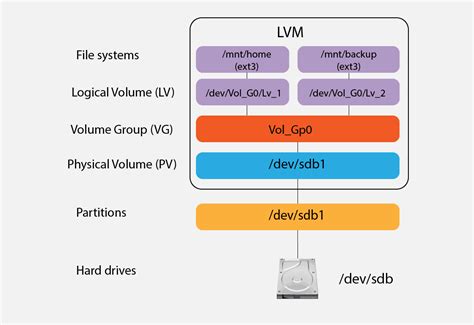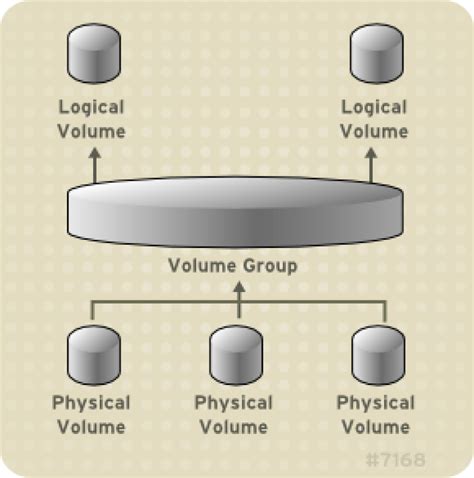lvm overview of pv and lv and vg | lvm physical volumes lvm overview of pv and lv and vg Learn how to use LVM, a device mapper framework that provides logical volume management for the Linux kernel. Find out the advantages, disadvantages, building blocks, and operations of .
January 1, 1880 - The construction of the Panama Canal begins under French auspices, although it would eventually fail on the sea level canal in 1893, and would be bought out .
0 · lvm volume sizes
1 · lvm volume group example
2 · lvm storage management structure
3 · lvm physical volumes
4 · lvm operations
5 · lvm functions
6 · lvm definition
7 · how to use lvm
The Rolex Explorer, like all Oyster Perpetual timepieces in Rolex’s Professional collection, is an expression of two technical milestones that Rolex and its visionary founder . See more
Learn how to use lvcreate command to create linear, striped, or RAID logical volumes with Logical Volume Manager (LVM) in Red Hat Enterprise Linux 8. See examples, options, and verification steps for each type of LV.Learn how to create, rename, extend, and combine volume groups (VGs) with .
Learn how to use LVM, or Logical Volume Management, to pool and abstract storage devices for flexible administration. This guide covers the basics of LVM architecture, terminology, and .

A physical volume (PV) is a partition or whole disk designated for LVM use. For more information, see Managing LVM physical volumes. Volume group. A volume group (VG) is a collection of .Learn how to create, rename, extend, and combine volume groups (VGs) with physical volumes (PVs) using LVM commands or the web console. VGs are storage entities that can manage .
Learn how to use LVM, a device mapper framework that provides logical volume management for the Linux kernel. Find out the advantages, disadvantages, building blocks, and operations of . Learn how Logical Volume Manager (LVM) works in Linux and Unix to manage storage flexibly and efficiently. Understand the LVM components, architecture, types, and .
lvm volume sizes
Learn how to use LVM to manage disk space flexibly and efficiently in Linux. See how to create, expand, and reduce logical volumes and filesystems with examples and .

Learn what LVM (Logical Volume Manager) is, how it works, and how to use it to manage storage on Linux systems. This tutorial covers the basics of LVM components, . This comprehensive guide navigates through the fundamental components of LVM — Physical Volumes (PV), Volume Groups (VG), and Logical Volumes (LV).
Learn how to use lvcreate command to create linear, striped, or RAID logical volumes with Logical Volume Manager (LVM) in Red Hat Enterprise Linux 8. See examples, options, and verification steps for each type of LV.
Learn how to use LVM, or Logical Volume Management, to pool and abstract storage devices for flexible administration. This guide covers the basics of LVM architecture, terminology, and commands on Linux systems.
lvm volume group example
A physical volume (PV) is a partition or whole disk designated for LVM use. For more information, see Managing LVM physical volumes. Volume group. A volume group (VG) is a collection of physical volumes (PVs), which creates a pool of disk space out of which you can allocate logical volumes. For more information, see Managing LVM volume groups.
Learn how to create, rename, extend, and combine volume groups (VGs) with physical volumes (PVs) using LVM commands or the web console. VGs are storage entities that can manage and resize multiple PVs and logical volumes (LVs). Learn what LVM (Logical Volume Manager) is, how it differs from partitioning, and how to create and manage logical volumes in Linux. Follow the steps with Vagrant and VirtualBox to practice LVM commands in a virtual environment.
Learn how to use LVM, a device mapper framework that provides logical volume management for the Linux kernel. Find out the advantages, disadvantages, building blocks, and operations of LVM, as well as how to create, resize, and encrypt logical volumes. Learn how Logical Volume Manager (LVM) works in Linux and Unix to manage storage flexibly and efficiently. Understand the LVM components, architecture, types, and commands with examples and diagrams.
Learn how to use LVM to manage disk space flexibly and efficiently in Linux. See how to create, expand, and reduce logical volumes and filesystems with examples and commands. Learn what LVM (Logical Volume Manager) is, how it works, and how to use it to manage storage on Linux systems. This tutorial covers the basics of LVM components, installation, partitioning, volume creation, and file system initialization.
This comprehensive guide navigates through the fundamental components of LVM — Physical Volumes (PV), Volume Groups (VG), and Logical Volumes (LV).Learn how to use lvcreate command to create linear, striped, or RAID logical volumes with Logical Volume Manager (LVM) in Red Hat Enterprise Linux 8. See examples, options, and verification steps for each type of LV. Learn how to use LVM, or Logical Volume Management, to pool and abstract storage devices for flexible administration. This guide covers the basics of LVM architecture, terminology, and commands on Linux systems.A physical volume (PV) is a partition or whole disk designated for LVM use. For more information, see Managing LVM physical volumes. Volume group. A volume group (VG) is a collection of physical volumes (PVs), which creates a pool of disk space out of which you can allocate logical volumes. For more information, see Managing LVM volume groups.
lvm storage management structure
Learn how to create, rename, extend, and combine volume groups (VGs) with physical volumes (PVs) using LVM commands or the web console. VGs are storage entities that can manage and resize multiple PVs and logical volumes (LVs). Learn what LVM (Logical Volume Manager) is, how it differs from partitioning, and how to create and manage logical volumes in Linux. Follow the steps with Vagrant and VirtualBox to practice LVM commands in a virtual environment.

Learn how to use LVM, a device mapper framework that provides logical volume management for the Linux kernel. Find out the advantages, disadvantages, building blocks, and operations of LVM, as well as how to create, resize, and encrypt logical volumes. Learn how Logical Volume Manager (LVM) works in Linux and Unix to manage storage flexibly and efficiently. Understand the LVM components, architecture, types, and commands with examples and diagrams. Learn how to use LVM to manage disk space flexibly and efficiently in Linux. See how to create, expand, and reduce logical volumes and filesystems with examples and commands. Learn what LVM (Logical Volume Manager) is, how it works, and how to use it to manage storage on Linux systems. This tutorial covers the basics of LVM components, installation, partitioning, volume creation, and file system initialization.
small goyard bag tote
women's goyard bags
• January 2 – British Expedition to Abyssinia: Robert Napier leads an expedition to free captive British officials and missionaries. • January 3 – The 15-year-old Mutsuhito, Emperor Meiji of Japan, declares the Meiji Restoration, his own restoration to full power, under the influence of supporters from the Chōshū and Satsuma Domains, and against the supporters of the Tokugawa shogunate, tri.
lvm overview of pv and lv and vg|lvm physical volumes


























